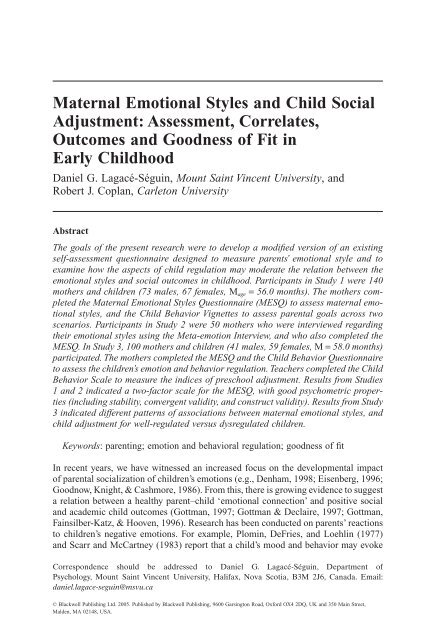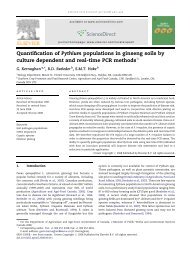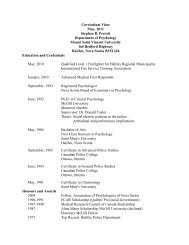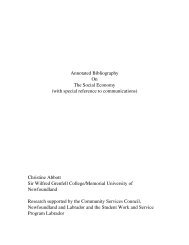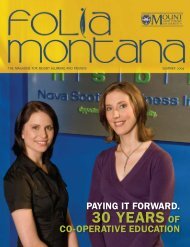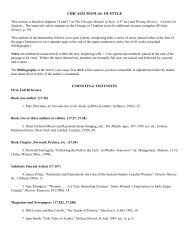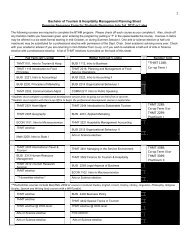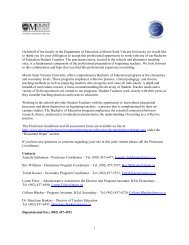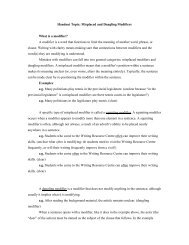Maternal Emotional Styles and Child Social Adjustment: Assessment ...
Maternal Emotional Styles and Child Social Adjustment: Assessment ...
Maternal Emotional Styles and Child Social Adjustment: Assessment ...
You also want an ePaper? Increase the reach of your titles
YUMPU automatically turns print PDFs into web optimized ePapers that Google loves.
<strong>Maternal</strong> <strong>Emotional</strong> <strong>Styles</strong> <strong>and</strong> <strong>Child</strong> <strong>Social</strong><strong>Adjustment</strong>: <strong>Assessment</strong>, Correlates,Outcomes <strong>and</strong> Goodness of Fit inEarly <strong>Child</strong>hoodDaniel G. Lagacé-Séguin, Mount Saint Vincent University, <strong>and</strong>Robert J. Coplan, Carleton UniversityAbstractThe goals of the present research were to develop a modified version of an existingself-assessment questionnaire designed to measure parents’ emotional style <strong>and</strong> toexamine how the aspects of child regulation may moderate the relation between theemotional styles <strong>and</strong> social outcomes in childhood. Participants in Study 1 were 140mothers <strong>and</strong> children (73 males, 67 females, M age = 56.0 months). The mothers completedthe <strong>Maternal</strong> <strong>Emotional</strong> <strong>Styles</strong> Questionnaire (MESQ) to assess maternal emotionalstyles, <strong>and</strong> the <strong>Child</strong> Behavior Vignettes to assess parental goals across twoscenarios. Participants in Study 2 were 50 mothers who were interviewed regardingtheir emotional styles using the Meta-emotion Interview, <strong>and</strong> who also completed theMESQ. In Study 3, 100 mothers <strong>and</strong> children (41 males, 59 females, M = 58.0 months)participated. The mothers completed the MESQ <strong>and</strong> the <strong>Child</strong> Behavior Questionnaireto assess the children’s emotion <strong>and</strong> behavior regulation. Teachers completed the <strong>Child</strong>Behavior Scale to measure the indices of preschool adjustment. Results from Studies1 <strong>and</strong> 2 indicated a two-factor scale for the MESQ, with good psychometric properties(including stability, convergent validity, <strong>and</strong> construct validity). Results from Study3 indicated different patterns of associations between maternal emotional styles, <strong>and</strong>child adjustment for well-regulated versus dysregulated children.Keywords: parenting; emotion <strong>and</strong> behavioral regulation; goodness of fitIn recent years, we have witnessed an increased focus on the developmental impactof parental socialization of children’s emotions (e.g., Denham, 1998; Eisenberg, 1996;Goodnow, Knight, & Cashmore, 1986). From this, there is growing evidence to suggesta relation between a healthy parent–child ‘emotional connection’ <strong>and</strong> positive social<strong>and</strong> academic child outcomes (Gottman, 1997; Gottman & Declaire, 1997; Gottman,Fainsilber-Katz, & Hooven, 1996). Research has been conducted on parents’ reactionsto children’s negative emotions. For example, Plomin, DeFries, <strong>and</strong> Loehlin (1977)<strong>and</strong> Scarr <strong>and</strong> McCartney (1983) report that a child’s mood <strong>and</strong> behavior may evokeCorrespondence should be addressed to Daniel G. Lagacé-Séguin, Department ofPsychology, Mount Saint Vincent University, Halifax, Nova Scotia, B3M 2J6, Canada. Email:daniel.lagace-seguin@msvu.ca© Blackwell Publishing Ltd. 2005. Published by Blackwell Publishing, 9600 Garsington Road, Oxford OX4 2DQ, UK <strong>and</strong> 350 Main Street,Malden, MA 02148, USA.
614 Daniel G. Lagacé-Séguin <strong>and</strong> Robert J. Coplanparticular reactions from others. A child with a temperamentally moody dispositionwill elicit moody reactions from peers <strong>and</strong> parents, whereas a child with a temperamentallyeasy disposition may not lead to the same outcomes (Plomin et al., 1977).In turn, these social reactions are likely to influence the child’s development <strong>and</strong> thegrowth of personality attributes (Thompson, 1999).Cook, Kenny, <strong>and</strong> Goldstein (1991) <strong>and</strong> Fish, Stifter, <strong>and</strong> Belsky (1991) found thatnegative parental affect toward children might be a consequence of adolescents’ <strong>and</strong>young children’s expression of negative affect toward their parents. Further evidencecomes from Eisenberg <strong>and</strong> Fabes (1994) who found a link between mothers’ perceptionsof their children’s temperament <strong>and</strong> mothers’ reactions to their children’s negativeemotions. In another study, mothers’ perceptions of girls’ negative emotionalitywere positively associated with mothers who were minimizing their children’s negativeemotion, <strong>and</strong> were negatively associated with reports of helping to solve the issuethat resulted in the negative emotion (Eisenberg, Fabes, & Murphy, 1997).Gottman, Fainsilber-Katz, <strong>and</strong> Hooven (1997) have recently proposed that parentalmeta-emotion philosophy represents an important component of how children’s emotionsare socialized. Meta-emotion philosophy can be conceptualized as an emotionalunderst<strong>and</strong>ing between parents <strong>and</strong> children, <strong>and</strong> can theoretically be understood asan ‘organized set of feelings <strong>and</strong> cognitions regarding one’s own emotions <strong>and</strong> theemotions of others’ (Gottman et al., 1997, p. 7). One possible outcome of a strongemotional connection between parents <strong>and</strong> children is a heightened emotional underst<strong>and</strong>ing.This emotional underst<strong>and</strong>ing would lead to the development of an advancedrepertoire of skills that would continually develop over the life span. Gottman <strong>and</strong>Declaire (1997) insist that children who are products of close emotional relationshipswith their parents will thrive in society because they will develop as ‘emotionallyintelligent’ people.According to Salovey <strong>and</strong> Mayer (1990), emotional intelligence has a substantialimpact on human development <strong>and</strong> functioning. Through an exhaustive analysis of theintelligence research, the authors argued that emotional intelligence comprises theability to monitor the self <strong>and</strong> others, the aptitude to discriminate among variations ofemotions, <strong>and</strong> the skills necessary to employ emotional information to guide behavior<strong>and</strong> cognitions. They argue that these skills are the driving force behind successfulsocial <strong>and</strong> emotional development. Goleman (1995) supports this position <strong>and</strong> addsthat childhood is the optimal time to secure <strong>and</strong> shape children’s ‘lifelong emotionalpropensities’ (p. 226).One of the elements that may influence the aspects of emotional intelligence is themother’s own ability to regulate emotions. Denham, Renwick-DeBardi, <strong>and</strong> Hewes(1994) explored naturally occurring dyadic communication between mothers <strong>and</strong> theirchildren. Their findings included that mothers who were skilled at regulating their ownemotions (i.e., duration of sadness) had children who were more likely to attend topeers’ emotions <strong>and</strong> engage in helping behavior. In contrast, long-term negative emotionalcommunication may be counterproductive to a child’s emotional development.Denham et al. (1994) reported that children whose mothers exhibit intense, longlasting,negative emotions may be ‘less likely than other children to respond prosociallyto their mothers’ or peers’ emotions’ (p. 503).Drawing on these findings, it is clear that an early emotional connection betweenparents <strong>and</strong> their children is important from a developmental perspective. For one, thebetter the connection, the more likely it is that a child will have an advanced abilityto empathize with others (Gottman et al., 1997). Empathy has been found to be© Blackwell Publishing Ltd. 2005 <strong>Social</strong> Development, 14, 4, 2005
<strong>Maternal</strong> <strong>Emotional</strong> <strong>Styles</strong> 615important to the development of language, regulation skills, socio-dramatic play,morals, <strong>and</strong> attachment (L<strong>and</strong>y, 1992).Surprisingly, there have been only a limited number of studies where researchershave explored relations between parental emotional styles <strong>and</strong> child outcomes. Thismay be partly due to the time-consuming nature of the Meta-emotion Interview (MEI)(Fainsilber-Katz & Gottman, 1999) that has remained the sole method of assessingparental emotional styles. In addition, the lack of research in the area may be attributedto the paucity of literature supporting that the MEI is a valid <strong>and</strong> a reliablemeasure of Meta-emotion Philosophy, <strong>and</strong> therefore, parental emotional styles.The goals of the present research were to develop a modified version of an existingself-assessment questionnaire (Gottman & Declaire, 1997) designed to measureparents’ emotional style, <strong>and</strong> to explore relations between emotional styles <strong>and</strong> childadjustment in preschool. Three studies were conducted to accomplish these goals. Thefirst two studies were concerned with the development <strong>and</strong> psychometric validationof the <strong>Maternal</strong> <strong>Emotional</strong> <strong>Styles</strong> Questionnaire (MESQ). In the third study, the direct<strong>and</strong> interactive relations among maternal emotional styles, aspects of child regulation,<strong>and</strong> indices of social adjustment to preschool were explored.Parental <strong>Emotional</strong> <strong>Styles</strong>Researchers have become increasingly interested in the impact of parenting on thesocialization of children’s emotions (e.g., see Denham, 1998; Ramsden & Hubbard,2002). Gottman et al. (1996, 1997) outlined the conceptual underpinnings of thetheory of parental meta-emotion. Meta-emotion refers to an ‘organized set of feelings<strong>and</strong> cognitions regarding one’s own emotions <strong>and</strong> the emotions of others’ (Gottmanet al., 1997, p. 7). As such, Gottman et al. (1996) proposed that parents who internalizeversus those who fail to internalize the ‘emotional’ knowledge of themselves<strong>and</strong> their children exhibit at least two parenting characteristics. 1 These characteristicshave been defined as an emotion-coaching (EC) <strong>and</strong> emotion-dismissing (ED) typology,respectively.EC parenting style is defined as parents’awareness of emotions within themselves <strong>and</strong>their children, <strong>and</strong> the ability to use this awareness to benefit their children’s socialization.Parents who espouse this particular parenting style are aware of their own emotions,can talk regarding these emotions in a differentiated manner, are aware of theseemotions in their children, <strong>and</strong> assist their children with their emotions (particularlynegative emotions) (Fainsilber-Katz, Gottman, & Hooven, 1996; Gottman & Declaire,1997; Gottman et al., 1996, 1997; Hooven, Gottman, & Fainsilber-Katz, 1995).Emotion coaches value a child’s negative emotions as an opportunity for intimacy <strong>and</strong>can tolerate spending time with a sad, angry, or fearful child without becoming impatientwith the emotion. Furthermore, EC parents perceive the realm of negative emotionsas an important arena for parenting, are sensitive to their children’s emotionalstates, respect their children’s emotions, <strong>and</strong> use emotional situations constructively.For instance, an emotion coach would use emotional moments to listen to a child,empathize with soothing words <strong>and</strong> affection, help the child label the emotion thathe or she is feeling, offer guidance on regulating the emotions, set limits, <strong>and</strong> teach acceptableexpression of emotions <strong>and</strong> problem-solving skills (Denham, 1998; Fainsilber-Katz et al., 1996; Gottman & Declaire, 1997; Gottman et al., 1996, 1997; Hooven etal., 1995). Gottman et al. (1997) reported that this form of parenting is associated withchildren’s increased trust of their feelings, better emotion regulation (ER), <strong>and</strong> more© Blackwell Publishing Ltd. 2005 <strong>Social</strong> Development, 14, 4, 2005
616 Daniel G. Lagacé-Séguin <strong>and</strong> Robert J. Coplancompetent problem-solving skills. Additionally, as compared with their peers, childrenof emotional coaches tend to have higher self-esteem, perform better academically, <strong>and</strong>have more positive peer relations (Gottman & Declaire, 1997).ED parenting style refers to a lack of awareness, <strong>and</strong> therefore, a diminished abilityto deal with children’s emotions. Characteristically, such parents lack awareness ofemotions within themselves <strong>and</strong> their children, fear being emotionally out of control,are unaware of techniques to address negative emotions, <strong>and</strong> believe that negative emotionsare a reflection of poor parenting skills (Gottman et al., 1997). Furthermore,instead of addressing displays of negative emotions, ED parents ignore or dismissemotions, attempt to immediately rid their children of the negative emotions, <strong>and</strong> striveto reassure their children that negative feelings always pass quickly <strong>and</strong> without lastingeffects. <strong>Child</strong>ren with dismissing parents are more likely to believe that their negativefeelings are inappropriate <strong>and</strong> not valid under any circumstances (Fainsilber-Katzet al., 1996; Gottman & Declaire, 1997; Hooven et al., 1995).Assessing Parental <strong>Emotional</strong> <strong>Styles</strong>Fainsilber-Katz <strong>and</strong> Gottman (1999) developed the MEI (Revised) to assess the elementsof a meta-emotion philosophy. The MEI is a semi-structured interview whereparents are probed regarding their feelings in response to various emotions. Specificquestions focus on the interviewees’ awareness, acceptance, <strong>and</strong> regulation of theirown negative emotions. Similar questions are then posed related to the parents’ awareness,acceptance, regulation, <strong>and</strong> coaching of their children’s emotions (see Gottmanet al., 1996 for a more detailed description). These characteristics are used to yieldscores that represent the components of a meta-emotion philosophy. Emotion coachesscore high on awareness, acceptance, regulation, <strong>and</strong> coaching, whereas emotion dismissersscore low on these same parental typologies. The MEI typically requires about90 minutes to administer. Moreover, specialized training is required to conduct theinterview. To date, the MEI has represented the only method of assessing parentalemotional styles. This factor has likely contributed toward the relative paucity ofresearch in this area.<strong>Emotional</strong> <strong>Styles</strong> <strong>and</strong> Other Parenting VariablesThe relations between emotional parenting styles <strong>and</strong> other parenting variables havenot been extensively studied. However, in a seminal article, Darling <strong>and</strong> Steinberg(1993) reported that parenting occurs within a particular emotional climate, which isthe driving force for other parenting behaviors <strong>and</strong> cognitions. Gottman et al. (1996)have argued that parental emotional styles are global in nature, nested within variousaspects of positive <strong>and</strong> negative parenting (including parental feelings <strong>and</strong> cognitionsregarding child rearing). In this regard, we might expect parental emotional styles tobe related to different components of parental belief systems. In the present study, weexplored the relations between EC <strong>and</strong> ED parenting styles <strong>and</strong> maternal goals inresponse to positive <strong>and</strong> negative child behaviors. The relations were explored as ameasure of construct validity for the MESQ.Parenting GoalsParenting goals are the outcomes that parents hope to achieve during interactionswith their children (Dix, 1992). Goals are experienced within specific child-rearing© Blackwell Publishing Ltd. 2005 <strong>Social</strong> Development, 14, 4, 2005
618 Daniel G. Lagacé-Séguin <strong>and</strong> Robert J. Coplanto be indicative of attentional control, <strong>and</strong> therefore outlines the importance of consideringthe multifaceted nature of regulation. As such, in the present study, we alsoincluded a measure of aspects of child behavioral regulation.Eisenberg <strong>and</strong> Fabes (1992, 1994, 1995) have defined elements of ER as involvingthe control of imposing stimuli <strong>and</strong> intrinsic states. A child’s ability to initiate, maintain,or change internal states is yet another conceptualization of ER. This view of ERhas its foundation in a theory based on child temperament that involves attentionprocesses such as attention shifting <strong>and</strong> attention focusing. However, in the currentstudy, we also assessed aspects of behavioral regulation, which involve the abilityto control the behavioral expression of impulses <strong>and</strong>/or feelings (Eisenberg, 1996;Eisenberg et al., 1999). In other words, regulation may also be conceptualized as themanagement of emotionally driven behavior (once emotion has occurred). A child whocan successfully adjust his or her behavior would be characterized as having goodbehavioral-regulation ability. Thus, the research supports that the critical differencebetween emotion <strong>and</strong> behavioral regulation is the locus of regulation: internal psychological<strong>and</strong> physiological reactions or overt behaviors.Both forms of regulation have been related to a number of child outcomes (e.g.,Caspi, Henry, McGee, Moffitt, & Silva, 1995; Eisenberg, Shepard, Fabes, Murphy, &Guthrie, 1998). For example, ER has been found to be positively related to severalsocial-adjustment constructs relevant to social competence (Rothbart, Ahadi, &Hershey, 1994). Eisenberg, Fabes, Murphy, Maszk, Smith, <strong>and</strong> Karbon (1995) alsoreported that behavioral regulation was positively related to socially appropriatebehavior (including low levels of aggressive <strong>and</strong> disruptive behavior), social skills,<strong>and</strong> sociometric status.Parental emotional styles have been linked conceptually <strong>and</strong> empirically with thedevelopment <strong>and</strong> maintenance of child regulatory abilities. Gottman et al. (1996,1997) argued that parental coaching philosophies regarding the expression of emotionaffect parents’ inhibition of negative affect toward their children <strong>and</strong> facilitate positiveparenting, as well as directly affect children’s regulatory physiology <strong>and</strong> abilityto regulate their own emotions. Antithetically, children whose parents dismiss negativeemotions <strong>and</strong> do not talk with them regarding these emotions in a supportive waywould be relatively low in their ability to manage both their emotions <strong>and</strong> their attentionin social situations. There is some empirical support for these notions (Eisenberg& Fabes, 1994; Eisenberg et al., 1997). It may be speculated that these dismissivecharacteristics would not provide the necessary environment for children to constructthe tools that are needed to deal with highly emotional states.Whereas previous researchers (e.g., Fainsilber-Katz et al., 1996; Gottman et al.1996, 1997; Hooven et al., 1995) have explored the linear <strong>and</strong> mediated relationsbetween ER, parental emotional styles, <strong>and</strong> indices of child adjustment, in the presentstudy we sought to pursue relations beyond what currently exist <strong>and</strong> explore themoderating role of child regulation. There is some evidence to suggest that childregulation might interact with certain parenting variables in the prediction of childoutcomes (Campbell, 1997; Martin, 1981; Stice & Gonzales, 1998). For example,Martin (1981) found that the combination of high mother responsiveness <strong>and</strong> lowinfant dem<strong>and</strong>ingness influenced later child compliance. Stice <strong>and</strong> Gonzales (1998)also reported that maternal <strong>and</strong> paternal control evidenced stronger relations to antisocialbehavior at elevated levels of behavioral under-control. The same study reportedthat the combination of paternal support <strong>and</strong> behavioral under-control was associatedwith risky behavior such as illicit drug use.© Blackwell Publishing Ltd. 2005 <strong>Social</strong> Development, 14, 4, 2005
<strong>Maternal</strong> <strong>Emotional</strong> <strong>Styles</strong> 619To date, however, researchers have not explored how emotional styles mightinteract with child-regulation abilities in the prediction of adjustment. As such, themajor goal of this third study was to explore how maternal emotional styles mightinteract with child regulation in the prediction of adjustment outcomes. It was hypothesizedthat ED parenting style may not be associated with negative outcomes amongchildren with higher regulatory ability (high ER <strong>and</strong>/or high behavioral regulation),<strong>and</strong> that a coaching style may be associated with positive outcomes with childrenrated with an opposite pattern of regulatory characteristics.OverviewThe goals of the current set of studies were to develop <strong>and</strong> validate a new parentalrating scale designed to assess EC <strong>and</strong> ED parenting styles, <strong>and</strong> to explore how maternalemotional styles are related to child regulation <strong>and</strong> social developmental outcomes.In Study 1, the factor structure <strong>and</strong> short-term stability of the MESQ were examined.The MESQ comprises items that probe mothers regarding the way they cope with theirown emotions <strong>and</strong> their children’s emotions, <strong>and</strong> how their children cope with theirown emotions. The focus of this study was on negative emotions. The relationsbetween MESQ subscales <strong>and</strong> parental goals were also explored as a measure of convergentvalidity. In Study 2, the construct validity of the MESQ was assessed byexploring the relation between maternal emotional styles as assessed by the MESQ<strong>and</strong> the MEI. Finally, in Study 3, a moderated model was tested to examine the predictionof child outcomes from the interaction between parental emotional styles <strong>and</strong>child behavior <strong>and</strong> ER.Study 1: Development of the MESQMethodsParticipantsOne hundred <strong>and</strong> forty mothers 2 with preschool-aged children (73 males, 67 females,M = 56.0, SD = 7.34 months) attending nine local childcare centers in <strong>and</strong> arounddiverse areas of Ottawa, Canada participated in this study. The mothers’ ages rangedfrom 26 to 38 years (M age = 32.0, SD age = 6.0), <strong>and</strong> they are predominately European-Canadian (78.6 per cent) <strong>and</strong> had primarily university (63.5 per cent) or college(25.7 per cent) education. All mothers received an information <strong>and</strong> questionnairepackage from the director of their day care. Those mothers who decided to participatereturned the package within two weeks.Measures<strong>Maternal</strong> <strong>Emotional</strong> <strong>Styles</strong>. The MESQ was developed to assess maternal EC <strong>and</strong> EDstyles. An original pool of 45 items representing EC <strong>and</strong> ED parenting styles wasadopted from a pre-existing scale of more than 100 items representing additional emotionalstyles beyond those of EC <strong>and</strong> ED styles (Gottman & Declaire, 1997). The scalehad yet to have been examined for its psychometric properties (Gottman, 1999). The45 items represented a combination of fear, anger, <strong>and</strong> sadness emotions across thetwo emotional styles. Given that the focus of this study was to measure EC <strong>and</strong> EDstyles of parenting, items representing two other styles of parenting, laissez-faire <strong>and</strong>© Blackwell Publishing Ltd. 2005 <strong>Social</strong> Development, 14, 4, 2005
620 Daniel G. Lagacé-Séguin <strong>and</strong> Robert J. Copl<strong>and</strong>isapproving, were not included in the original item pool. The 45 items were r<strong>and</strong>omizedfor order, <strong>and</strong> responses were solicited on a 5-point Likert scale anchoredfrom 1 (strongly disagree) to 5 (strongly agree). Six months after completing theMESQ, a subsample of n = 64 mothers completed the scale again.Parental Goals. The parental goals were assessed in a subsample of n = 75 mothersusing the <strong>Child</strong> Behavior Vignettes (CBV) (Hastings & Coplan, 1999; Hastings &Grusec, 1998). The CBV was designed to assess parental goals across a variety ofsituational contexts <strong>and</strong> has demonstrated good psychometric properties (Coplan et al.,2002; Hastings & Coplan, 1999). Of interest in the present study was the vignetterelated to child pro-social behavior, as well as three vignettes related to negative childbehaviors (i.e., aggression, <strong>and</strong> misbehavior in a public <strong>and</strong> a private setting). Followingeach vignette, the mothers rated on a scale from 1 to 5 how important eachof five possible parenting goals would be for them in that situation. These includedtwo parent-centered goals (‘wanting the child to immediately behave properly’ <strong>and</strong>‘wanting the child to know that his or her mother expects proper behavior’) <strong>and</strong> threeempathetic goals (‘wanting the child to be happy’, ‘wanting the child <strong>and</strong> mother tofeel good’, <strong>and</strong> ‘wanting the child to trust the mother <strong>and</strong> know that the mother loveshim or her’). Following Hastings <strong>and</strong> Coplan (1999), the aggression <strong>and</strong> misbehaviorscenarios were aggregated to create a measure of parental goals in response to negativechild behavior. In the current study, the alphas for parent-centered <strong>and</strong> empatheticgoals across the pro-social <strong>and</strong> negative-behavior settings ranged from .73 to .81.Results <strong>and</strong> DiscussionPsychometric Properties of the MESQGiven that the major goal of Study 1 was to develop a short-rating scale, our first taskwas to reduce the number of items. To do this, the distributions of scores for the MESQoriginal pool of 45 items (see Table 1) were explored by calculating the value of theskew statistic divided by the st<strong>and</strong>ard error of the skew. A total of 23 items wasdropped because of significantly skewed distributions <strong>and</strong> a lack of variability (i.e.,restricted range).The remaining 22 items were subjected to exploratory factor analysis using principlecomponents analysis extraction with Varimax rotation. Given that there were highcross-loadings between some variables or low-factor loadings, eight more items weredropped <strong>and</strong> a Varimax 3 rotation was again performed. The results indicated a twofactorsolution (i.e., two factors had eigenvalues greater than 1.0). Together, these twofactors accounted for 67.2 percent of the variance. The factor loadings for each subscaleare shown in Table 2. 4Table 1. The <strong>Maternal</strong> <strong>Emotional</strong> Style Questionnaire—Original Item Pool1. <strong>Child</strong>ren really have very little to be sad about.2. I think that anger is okay as long as it is under control.3. When my child is sad, it’s time to problem-solve.4. Anger is an emotion worth exploring.5. When my child is sad, I am expected to fix the world <strong>and</strong> make it perfect.6. When my child gets sad, it’s time to get close.© Blackwell Publishing Ltd. 2005 <strong>Social</strong> Development, 14, 4, 2005
<strong>Maternal</strong> <strong>Emotional</strong> <strong>Styles</strong> 621Table 1. Continued7. When my child is sad, I try to help him/her explore what is making him/hersad.8. I really have no time for sadness in my life.9. If you ignore a child’s sadness it tends to go away <strong>and</strong> take care of itself.10. When my child is sad, I show my child that I underst<strong>and</strong>.11. I want my child to experience sadness.12. The important thing is to find out why a child is feeling sad.13. I think sadness is okay as long as it’s under control.14. Sadness is something that one has to get over, to ride out, not to dwell on.15. I don’t mind dealing with children’s sadness, so long as it doesn’t last too long.16. When my child is sad we sit down to talk over the sadness.17. I prefer a happy child to a child who is overly emotional.18. I help my child get over sadness quickly so he/she can move on to otherthings.19. When my child is sad, I try to help him/her figure out why the feeling is there.20. When my child is angry, it’s an opportunity for getting close.21. When my child is angry, I take some time to try to experience this feelingwith my child.22. I want my child to experience anger.23. I don’t see a child being sad as any kind of opportunity to teach the childmuch.24. I think that when kids are sad they have overemphasized the negative in life.25. I think it is good for kids to experience anger sometimes.26. The important thing is to find out why the child is feeling angry.27. When my child is angry, I try to be underst<strong>and</strong>ing of his/her mood.28. I try to change my child’s angry moods into cheerful ones.29. <strong>Child</strong>ren really have very little to be angry about.30. <strong>Child</strong>hood is a happy-go-lucky time, not a time for feeling sad or angry.31. I’m not really trying to teach my child anything in particular about sadness.32. When my child gets angry my goal is to get him/her to stop.33. I want my child to get angry, to st<strong>and</strong> up for him-/her/herself.34. When my child is angry I want to know what he/she is thinking.35. I don’t make a big deal of a child’s anger.36. When my child is mad, I just find out what is making him/her mad.37. It’s important to help my child find out what caused his/her anger.38. When my child is angry, I usually don’t take it that seriously.39. When my child gets angry with me, I think, ‘I don’t want to hear this.’40. A child’s anger is important.41. When my child is angry I think ‘if only he/she could roll with the punches.’42. When my child gets angry I think, ‘Why can’t he/she accept things as theyare?’43. When my child is angry, it’s time to solve a problem.44. I don’t make a big deal out of my child’s sadness.45. <strong>Child</strong>ren have a right to feel angry.Note: Items in bold remained in the final questionnaire.© Blackwell Publishing Ltd. 2005 <strong>Social</strong> Development, 14, 4, 2005
622 Daniel G. Lagacé-Séguin <strong>and</strong> Robert J. CoplanTable 2. Factor Loadings for the Two-factor Solution to the <strong>Maternal</strong> <strong>Emotional</strong>Style Questionnaire (n = 140)FactorLoadingItem (Abbreviated) I IISadness is something that one has to get over with, to ride out, <strong>and</strong> .83not to dwell on.I prefer my child to be happy rather than overly emotional. .86I help my child get over sadness quickly so that he/she can move on. .87I try to change my child’s angry mood into a cheerful one. .85<strong>Child</strong>hood is a happy-go-lucky time, not a time to feel sad or angry. .84When my child is angry, my goal is to make him/her stop. .88When my child is sad, I am expected to fix the world <strong>and</strong> make it .87perfect.When my child is angry, it’s an opportunity for getting close. .78When my child is angry, I take some time to experience this feelingwith him/her. .75When my child is sad, it’s time to solve his/her problem. .77When my child is angry, I want to know what he/she is thinking. .78Anger is an emotion worth exploring. .76When my child is angry, it’s time to solve his/her problem. .79When my child is sad, it’s time to get close. .80Note: Only factor loadings above 0.30 are shown.The first factor, labeled ED, had an eigenvalue of 5.2 <strong>and</strong> accounted for 37.1 percentof variance in the data. The factor consisted of seven items referring to an EDphilosophy regarding maternal emotional styles <strong>and</strong> had factor loadings rangingbetween .83 <strong>and</strong> .88. The Cronbach’s alpha for this subscale was .92. The secondfactor, labeled EC, had an eigenvalue of 4.2 <strong>and</strong> accounted for 30.1 percent of thevariance. The seven items loading on this factor are referred to as EC parenting philosophy,<strong>and</strong> had item loadings ranging from .75 to .80. The alpha for this subscalewas .90.Stability of the MESQ RatingsThe short-term stability of the MESQ was assessed by correlating the maternalratings from the initial data collection with the ratings completed by a sample ofthe same mothers six months later (n = 64). The EC <strong>and</strong> ED subscales were createdby averaging across all items pertaining to the particular subscale. The resultsindicated moderate stability over six months for both ED r (63) = .58 <strong>and</strong> EC r (63)= .53.© Blackwell Publishing Ltd. 2005 <strong>Social</strong> Development, 14, 4, 2005
<strong>Maternal</strong> <strong>Emotional</strong> <strong>Styles</strong> 623Table 3. Correlations Between the <strong>Maternal</strong> <strong>Emotional</strong> Style Questionnaire <strong>and</strong>Parenting Goals (n = 75)<strong>Maternal</strong> <strong>Emotional</strong> <strong>Styles</strong>Parental Goal Emotion Coaching Emotion DismissingParent-centeredNegative behavior .15 .64*Pro-social .12 .39*EmpatheticNegative behavior .39* .15Pro-social .43* .20*p < .001.Parental GoalsThe correlations between the MESQ scales <strong>and</strong> parental goals are shown in Table 3.EC parenting was significantly <strong>and</strong> positively correlated with empathetic goals,accounting for 15.2 per cent of the variance in the negative-behavior scenario <strong>and</strong>18.5 per cent of the variance in the pro-social scenario. In contrast, ED parenting wassignificantly <strong>and</strong> positively related to parent-centered goals accounting for 40.9 percent of the variance in negative behavior <strong>and</strong> 15.2 per cent of the variance inpro-social behavior.ConclusionsThe primary goal of Study 1 was to develop <strong>and</strong> establish the psychometric propertiesof the MESQ, designed to assess EC <strong>and</strong> ED parenting styles. The results fromfactor analyses yielded a two-factor solution for the MESQ. The EC <strong>and</strong> ED scalescontained items that are theoretically consistent with their underlying conceptualcharacteristics as previously outlined by Gottman <strong>and</strong> Declaire (1997) <strong>and</strong> Gottmanet al. (1996, 1997). It was thought that if the MESQ could withst<strong>and</strong> a six-month stabilityperiod that it would be a fair indication of the enduring nature of emotionalstyles. In fact, the MESQ did demonstrate moderate stability over a six-month periodproviding further evidence that EC <strong>and</strong> ED typologies are elements of parenting thatseem to remain a constant device in parents’ repertoire of tools (Gottman et al., 1996,1997). Other researchers may want to investigate the nature of the emotional stylesover longer periods of time to determine the extent of endurance. Had the stabilitytime lapse been shorter, or had the MESQ not been found to be psychometricallyacceptable along the six-month period, it may have signaled the variability of EC <strong>and</strong>ED parenting typologies.It was interesting to note the positive relation between ED <strong>and</strong> parent-centered goalseven in the scenario depicting child pro-social behavior. It may be speculated thatmothers higher in the ED style may not have the emotional knowledge to deal with apositive emotional climate. It may be that these mothers feel the need to control at alltimes because they are not comfortable with positive or negative emotional situations.© Blackwell Publishing Ltd. 2005 <strong>Social</strong> Development, 14, 4, 2005
624 Daniel G. Lagacé-Séguin <strong>and</strong> Robert J. CoplanAs a result, they seek to control the situation while neglecting to share in the positivesituation with their child.In contrast, EC parenting was related to a greater focus on empathetic goals both insituations marked by misbehavior <strong>and</strong> pro-social interactions. Parents who focus onempathetic goals desire to address <strong>and</strong> meet both their <strong>and</strong> their children’s needs(Coplan et al., 2002). They also seek to solve problems in fair <strong>and</strong> balanced ways, reachmutually acceptable outcomes, <strong>and</strong> maintain the emotional harmony of their child(Hastings & Grusec, 1998). Our findings suggested that, even in the face of misbehavior,mothers rated as higher on EC were concerned with their relationships with theirchild <strong>and</strong> their child’s well-being. It may be that these mothers would be less controllingin their disciplinary actions, <strong>and</strong> this would lead to an environment in which theparents <strong>and</strong> their child can engage together in emotional learning. This is reminiscentof the characteristics of an EC mother outlined by Gottman et al. (1996, 1997).These findings provide some preliminary support for the psychometric properties,reliability, <strong>and</strong> convergent validity of the MESQ as a new rating-scale assessmentof maternal emotional styles. However, to demonstrate true construct validity, it isnecessary to demonstrate theoretically consistent relations between the MESQ <strong>and</strong> thetraditional interview assessment of maternal emotional styles. These associations wereexplored in Study 2.Study 2: Relations Between the MESQ <strong>and</strong> the MEIMethodsParticipantsFifty mothers with children attending nine local childcare centers in <strong>and</strong> arounddiverse areas of Halifax, Nova Scotia participated in this study. The mothers’ agesranged from 21 to 44 years (M age = 28 years, SD age = 4.3 years), <strong>and</strong> they were predominatelyCaucasian (98 per cent) who were working (48 per cent) or who held acollege diploma (30.0 per cent) or a university degree (11 per cent). All the motherswere informed <strong>and</strong> received a questionnaire package from the director of their daycare. Those mothers who agreed to participate returned the package within two weeks.MaterialsMEI. The maternal emotional styles were assessed using the MEI (Gottman et al.,1996). The interview was designed to measure parents’ responses to a variety of questionsrelating to their underst<strong>and</strong>ing of their own <strong>and</strong> their children’s emotions.Specific questions focus on the interviewees’ awareness, acceptance, <strong>and</strong> regulationof their own positive <strong>and</strong> negative emotions. Similar questions related to the parents’awareness, acceptance, regulation, <strong>and</strong> coaching of their children’s emotions (seeFainsilber-Katz & Gottman, 1999 for a more detailed description) are then posed. Forthe goals of Study 2, the question regarding children’s regulation of their own emotionswas not included in the analyses. The remaining variables are theoretically <strong>and</strong>empirically associated with one another in the conceptualization of meta-emotion,whereas the data regarding children’s regulation refer to what a child does during thetime of having the negative emotion <strong>and</strong> which do not necessarily relate to parenting. 5The awareness of emotions (e.g., ‘What is it like for you to be sad?’ <strong>and</strong> ‘What is itlike for your child to be sad?’) includes the ability to talk regarding emotions <strong>and</strong> the© Blackwell Publishing Ltd. 2005 <strong>Social</strong> Development, 14, 4, 2005
<strong>Maternal</strong> <strong>Emotional</strong> <strong>Styles</strong> 625acceptance of these emotions, the ability to distinguish one type of emotion fromanother, <strong>and</strong> interest in emotions. The acceptance of emotions (e.g., ‘What do youthink of sadness?’ <strong>and</strong> ‘What are your feelings when your child is sad?’) refers to thedegree to which emotions have a meaning or value. The regulation of emotions (e.g.,‘Is there anything you do to get over your sadness?’ <strong>and</strong> ‘How does your child getover sadness?’) concerns the ability to control the intensity of emotions. Finally,coaching a child’s emotion (e.g., ‘What do you do to help your child with thisemotion?’) involves helping a child label the emotional experience, accepting thechild’s emotion, teaching the child how to deal with intense emotions, <strong>and</strong> comfortingthe child having an intense emotional experience.The interview data were collected <strong>and</strong> videotaped by four trained researchers.However, before the data were collected, the researchers were trained on the MEI usingthe Meta-emotion Coding System Manual (Hooven, 1994). Training was conductedusing MEI recordings. The interview contains approximately 54 questions assessingthe self <strong>and</strong> a child’s emotions across three different emotional constructs (sadness,anger, <strong>and</strong> fear). On average, the MEI could be implemented within a 90-minuteperiod, but this depended on the length of a parent’s answers to the posed questions.The inter-rater reliability was computed for two pairs of researchers based on approximately120 minutes of interview data collected before the start of the study. Followingthe procedure outlined by Gottman et al. (1996), the correlations betweenindependent observers were examined to discern inter-rater reliability. For a completevariable matrix, the Cohen’s kappa coefficients between the pairs of observers were.84 <strong>and</strong> .88.The videotaped interviews were viewed later <strong>and</strong> summary scores were computedrepresenting the interviewees’ awareness, acceptance, <strong>and</strong> regulation of their ownemotions, as well as awareness, acceptance, <strong>and</strong> coaching of their child’s emotions.Correlations between these summary scores ranged from r = .37 (p < .05) to r = .74(p < .001). A global measure of a meta-emotion, EC philosophy (a =.79) was thencomputed.MESQ. The mothers also completed the 14-item MESQ previously described in Study1. The summary scores representing EC (seven items, a=.81) <strong>and</strong> ED parenting styles(seven items, a =.78) were computed.Results <strong>and</strong> DiscussionThe analyses revealed significant correlations between the MESQ subscales (EC M =3.86, SD = .61; ED M = 3.27, SD = .64) <strong>and</strong> MEI assessments of meta-EC style. Thescores from these measures were highly correlated for both EC (r = .73, p < .001)<strong>and</strong> ED (r = -.75, p < .001) styles as represented in the MESQ. Therefore, 54 <strong>and</strong>56 percent of the variance was shared between the two measures of EC <strong>and</strong> ED,respectively.The high degree of association between the MESQ <strong>and</strong> the MEI provides strongsupport for the construct validity of the MESQ as an alternative means for assessingEC <strong>and</strong> ED maternal styles. In agreement with the results of Study 1, the findingsfrom Study 2 provide compelling evidence to suggest that maternal emotional stylescan be reliably <strong>and</strong> validly assessed using this newly developed time-saving paper<strong>and</strong>-pencilmeasure. In Study 3, this new measure was used to further explore the relationsbetween maternal emotional styles <strong>and</strong> child adjustment in preschool.© Blackwell Publishing Ltd. 2005 <strong>Social</strong> Development, 14, 4, 2005
626 Daniel G. Lagacé-Séguin <strong>and</strong> Robert J. CoplanStudy 3: <strong>Maternal</strong> <strong>Emotional</strong> <strong>Styles</strong> <strong>and</strong> <strong>Child</strong> <strong>Adjustment</strong> to PreschoolIt was previously mentioned that there is a paucity of research to examine the relationshipbetween parental emotional styles <strong>and</strong> child regulation in the prediction ofsocial development in childhood. In some of the only published research works,Fainsilber-Katz et al. (1996), Gottman et al. (1996, 1997), <strong>and</strong> Hooven et al. (1995)have explored direct <strong>and</strong> indirect associations between ER, parental emotional styles,<strong>and</strong> indices of child adjustment. In another study, Ramsden <strong>and</strong> Hubbard (2002) foundthat there were no relations between the individual elements of a parent’s EC <strong>and</strong> achild’s aggressive tendencies. In Study 3, we sought to explore the moderating role ofchild regulation. As such, the goal of this study was to explore how maternal emotionalstyles might interact with aspects of child regulation in the prediction of adjustmentoutcomes. It was hypothesized that ED parenting style may not be associatedwith negative outcomes among children with higher regulatory ability (high ER <strong>and</strong>/orhigh behavioral regulation), <strong>and</strong> that a coaching style may be associated with positiveoutcomes with children rated with an opposite pattern of regulatory characteristics.MethodsParticipantsOne hundred mothers with children (41 males, 59 females, M age = 58.0 months, SD age= 6.03 months) attending seven local day care centers in <strong>and</strong> around diverse areas ofOttawa, Ontario, Canada participated in this study. The mothers’ ages ranged from 22to 31 years (M age = 28 years, SD age = 2 years), <strong>and</strong> they were predominately Caucasian(85 percent) <strong>and</strong> had university or college education (68 percent). All mothers wereinformed <strong>and</strong> received a questionnaire package from the director of their day care center.Those mothers who decided to participate returned the package within two weeks. Oncethe package had been returned, all teacher-based questionnaires were completed.Measures<strong>Maternal</strong> <strong>Emotional</strong> <strong>Styles</strong>. The mothers completed the MESQ to assess maternal EC<strong>and</strong> ED styles. The results from factor analyses in the current study replicated thefactor structure found in Study 1. In the current sample, estimates of the internal consistencyof items for ED <strong>and</strong> EC were high (0.80 <strong>and</strong> 0.78, respectively).Regulation. The parents also completed the <strong>Child</strong> Behavior Questionnaire (CBQ)(Rothbart, 1996). The CBQ scale ranges from 1 (extremely untrue of child) to 7(extremely true of child). The aspects of ER were assessed using items related to attentionfocusing (14 items, a=.75; e.g., ‘sometimes becomes absorbed in a picture book<strong>and</strong> looks at it for a long time’) <strong>and</strong> attention shifting (12 items, a =.78; e.g., ‘caneasily shift from one activity to another’). These two scales were significantly correlated(r = .76, p < .001), <strong>and</strong> thus combined to create an aggregate assessment ofemotional regulation (see also Eisenberg & Fabes, 1994, 1995). Two subscales wereused to assess behavioral regulation. These included items related to impulsivity (13items, a=.78; e.g., ‘usually rushes into an activity without thinking regarding it’) <strong>and</strong>inhibitory control (13 items, a =.74; e.g., ‘can wait before entering into a new activityif asked to’). These two scales were significantly correlated (r =-.77, p < .001),© Blackwell Publishing Ltd. 2005 <strong>Social</strong> Development, 14, 4, 2005
628 Daniel G. Lagacé-Séguin <strong>and</strong> Robert J. Coplanused a more dismissing approach to relating to their emotional needs. Given thecorrelational nature of this study, the causal nature of the relation between dismissingparenting <strong>and</strong> behavioral regulation is not clear. Results from several studies have indicatedthat positive parental intervention is related to significant changes in how childrenrelate to peers <strong>and</strong> others outside the home (e.g., Patterson, 1986; Tremblay,Vitaro, Gagnon, Piche, & Royer, 1992). In this regard, it may be argued that the lackof emotional awareness <strong>and</strong> support inherent in dismissing parenting contributestoward poorer child behavioral regulation. However, results from other studies havesuggested that children evoke certain responses from adults (Plomin et al., 1977; Scarr& McCartney, 1983). In this vein, a parent may become more ED because his or herchild’s emotional volatility has prompted feelings of helplessness in him or her.<strong>Assessment</strong> of Interactions 6In order to explore the interactive relations between maternal emotional styles <strong>and</strong>regulation in the prediction of indices of social development, a series of hierarchicalregression analyses was computed (see Aiken & West, 1991; Cohen & Cohen, 1983;Pedhazur, 1997). Separate equations were computed to predict each of the indices ofadjustment (e.g., pro-social behavior, anxiety). The ‘main effects’ variables (st<strong>and</strong>ardized)of EC, ED, BR, <strong>and</strong> ER were entered first. In the next step, the two-wayinteraction terms were entered—as represented by multiplicative products (coaching¥ ER, coaching ¥ BR, dismissing ¥ ER, <strong>and</strong> dismissing ¥ BR).Significant interactions were found between coaching <strong>and</strong> BR in the prediction ofpro-social behavior, coaching <strong>and</strong> ER in the prediction of anxiety, <strong>and</strong> dismissing <strong>and</strong>BR in the prediction of anxiety (see Table 4). This indicated that the relation betweenmaternal emotional style <strong>and</strong> these outcome variables varied significantly as a functionof emotion or BR. The interactions were statistically explored using simple slopeanalyses. Following st<strong>and</strong>ard procedures for performing simple slope analyses, thevalues of -1, 0, <strong>and</strong> 1 were used to designate low, medium, <strong>and</strong> high levels. The resultsare shown in Figure 1.EC was positively associated with pro-social behavior for children with lower BR(b=.33, p < .05), <strong>and</strong> with anxiety for children higher in ER (b=.31, p < .05), whereasED was positively associated with anxiety for children with higher levels of BRTable 4. Results of Regression Analyses Predicting Indices of <strong>Social</strong> <strong>Adjustment</strong>from Interactions Between Emotion Coaching (EC), Emotion Dismissing (ED),Emotion Regulation (ER), <strong>and</strong> Behavior Regulation (BR)Interaction Terms (sr 2 )Dependent Variable EC ¥ ER EC ¥ BR ED ¥ ER ED ¥ BRPro-social .010 .110* .005 .001Anxiety .040* .001 .002 .040*Aggression .002 .001 .003 .012*p < .05.© Blackwell Publishing Ltd. 2005 <strong>Social</strong> Development, 14, 4, 2005
<strong>Maternal</strong> <strong>Emotional</strong> <strong>Styles</strong> 6292.52.4Pro-social2.32.2low BRaverage BRhigh BR2.12LowEmotion coachingHigh1.5Anxiety1.41.31.2low ERaverage ERhigh ER1.11LowEmotion coachingHigh1.61.5Anxiety1.41.31.2low BRaverage BRhigh BR1.11LowEmotion dismissingHighFigure 1. Interactions between <strong>Maternal</strong> <strong>Emotional</strong> <strong>Styles</strong> <strong>and</strong> ER <strong>and</strong> BR in thePrediction of Pro-social Behavior <strong>and</strong> Anxiety.Note: BR, behavior regulation; ER, emotion regulation.© Blackwell Publishing Ltd. 2005 <strong>Social</strong> Development, 14, 4, 2005
630 Daniel G. Lagacé-Séguin <strong>and</strong> Robert J. Coplan(b =.32, p < .05). In contrast, for children with higher levels of BR, EC was unrelatedto pro-social behavior (b =-.23, NS). And, for children with lower levels ofemotion <strong>and</strong> BR, EC <strong>and</strong> ED were unrelated to anxiety (b =.17, NS; b =-.22, NS).Parenting, Regulation, <strong>and</strong> <strong>Adjustment</strong>Consistent with the previous research, our results indicated interactions between measuresof parenting <strong>and</strong> child regulation in the prediction of child social adjustment(e.g., Calkins, Gill, Johnson, & Smith, 1999; Campbell, 1997; Martin, 1981). Forexample, among children who were rated as more behaviorally dysregulated, maternalcoaching was positively associated with child pro-social behavior in preschool.Quite surprisingly, however, among more well-regulated children, maternal coachingwas positively associated with child anxiety in preschool. This unexpected result suggeststhat EC may not be the optimum style for socializing emotions for all children<strong>and</strong> under all circumstances. This may be a case of ‘goodness of fit’ or the extent towhich the dem<strong>and</strong>s of the environment are congruent with a child’s characteristics,capacities, <strong>and</strong> style of behaving (Thomas & Chess, 1977). Within the realm ofparent–child relationships, goodness of fit refers to the extent that parenting characteristics<strong>and</strong> child characteristics are well matched.In this regard, for more dysregulated children, the results were consistent with thenotion that EC acts as a protective factor against deleterious outcomes. EC motherswould be more likely to perceive heated emotional periods as important opportunitiesto teach. Presumably, the empathy, dyadic communication, <strong>and</strong> awareness of children’semotional state that accompanies an EC philosophy provide a ‘scaffolded’ environmentwithin which these children can develop coping skills that may be implementedduring later peer interactions. This represents a good ‘fit’.However, among more well-regulated children, the same maternal emotional stylewas related to increased child anxiety at preschool. It may be that for children whoare not disposed to emotional extremes, EC parenting might represent an ‘overfocus’on the socialization of emotion. Gottman et al. (1997) suggest that ‘being in tune’with a child’s negative emotions may foster his or her development. In this regard,for well-regulated children, EC may be a functional equivalent of emotionally oversolicitousparenting.Oversolicitous parents tend to overmanage situations for their children, restrict theirchildren’s behavior, be overly affectionate, discourage their children’s independence,<strong>and</strong> direct their children’s activities. As a result of this constricted environment, thechildren may not develop the necessary coping strategies (Rubin, Cheah, & Fox,2001). In support of this notion, results from several recent studies have documenteda relation between overprotective parenting <strong>and</strong> social wariness in early childhood(Lieb, Wittchen, Hoefler, Fuetsch, Stein, & Merikangas, 2000; Rubin et al., 2001;Rubin, Hastings, Stewart, Henderson, & Chen, 1997).In this same vein, it is possible that children who are not prone to emotional outburstsmay benefit from a parenting style less focused on the socialization of emotions.However, this is not to suggest that well-regulated children might benefit froman ED style.Our results also indicated a significant interaction between ED parenting style <strong>and</strong>BR in the prediction of anxious behavior. Among more well-regulated children, EDwas also significantly associated with anxiety in preschool. This relation was not foundamong more dysregulated preschoolers.© Blackwell Publishing Ltd. 2005 <strong>Social</strong> Development, 14, 4, 2005
<strong>Maternal</strong> <strong>Emotional</strong> <strong>Styles</strong> 631Emotion dysregulation has been linked to adjustment problems in preschool (e.g.,Caspi et al., 1995; Coplan, Wichmann, Lagace-Seguin, Rachlis, & McVey, 1999).Thus, it would appear as though ED parenting style among dysregulated children isnot associated with augmented maladjustment. Among well-regulated children, dismissingparenting seems to have a deleterious effect. Well-regulated children are notalways well regulated. According to Gottman et al. (1996, 1997), dismissing parentsfeel anxious, fearful, <strong>and</strong> overwhelmed by their own emotions <strong>and</strong> the emotions oftheir children. These parents also have feelings of under-control in emotionalsituations <strong>and</strong> lack the problem-solving ability to deal with emotional climates as theyarise. It is not difficult to imagine this dynamic contributing to a child’s feelings ofanxiety.Thus, we are left with the somewhat puzzling interpretive conclusion that neitherEC nor ED parenting style is conducive to positive outcomes for well-regulated children.The question is then raised as to what emotional style of parenting would bestsuit well-regulated children. Gottman <strong>and</strong> Declaire (1997) have described some othermeta-emotion philosophies (i.e., laissez-faire, disapproving). As such, future researchis required to explore these (<strong>and</strong> other) alternative emotional styles that may be moreappropriate for children who already possess above-average regulatory abilities.General DiscussionThe goals of the present research were to develop a rating-scale assessment of maternalemotional styles, <strong>and</strong> to explore relations between emotional styles <strong>and</strong> childadjustment in preschool. In the first two studies, the MESQ was developed <strong>and</strong> validatedas a rating-scale assessment of maternal EC <strong>and</strong> ED styles. The results fromthese studies indicated a two-factor scale for the MESQ, with acceptable psychometricproperties (including stability, convergent validity, <strong>and</strong> construct validity). InStudy 3, this new measure was employed to explore the associations between maternalemotional styles, child regulation, <strong>and</strong> adjustment to preschool. Three interactionsbetween emotional styles <strong>and</strong> child regulation were found in the prediction of adjustmentoutcomes. The results from follow-up analyses revealed some intriguing findingsregarding differential association between emotional styles <strong>and</strong> adjustment forchildren with different regulatory abilities.Future DirectionsThe results from the present research have provided strong psychometric support forMESQ, but it goes without saying that there are multiple risks replacing an interviewingmethod with a 14-item self-report measure. One obvious issue is that parentswho use a particular style may not be aware of adhering to one style over another.Therefore, a mother who espouses a dismissing style may not realize that her style ischaracteristic of a lack of emotional closeness. It must also be considered that someparents are more insightful than others <strong>and</strong> are more accurate in perceiving their emotionalparenting styles, whereas less insightful parents may act in response with whatthey think is socially desirable. Expectancy effects, such as these, need to be consideredin subsequent research. Therefore, it is hoped that future research will continueto examine the MESQ <strong>and</strong> its psychometric properties. However, the additionof this new measure to the extant literature will encourage increased investigations inthis area. In addition, some preliminary findings were presented regarding the potential© Blackwell Publishing Ltd. 2005 <strong>Social</strong> Development, 14, 4, 2005
632 Daniel G. Lagacé-Séguin <strong>and</strong> Robert J. Coplanimportance of child regulatory abilities as a moderating factor in the relation betweenparental emotional styles <strong>and</strong> child adjustment in preschool. It seems clear that futureresearch will be required to untangle the complex associations among these variables.There are also some additional issues to consider.It must be cautioned that the MESQ is based on parental responses to children’sangry <strong>and</strong> sad emotions. In general, much of the literature on the socialization ofchildren’s emotions has focused on negative emotions. It would serve the literaturewell to examine responses to other emotions, including positive emotions. Ourongoing investigation is focused on unravelling the complexities associated with thelinks between maternal emotional styles <strong>and</strong> children’s positive emotions. This, inaddition to the current empirical investigation, will provide researchers with the muchneededinformation.The mothers who participated in Study 3 reported their own maternal emotionalstyles as well as their children’s regulatory abilities. Therefore, shared methodvariance may have contributed to some of the reported findings. For example, a potentialbias may be evident in parents who espouse a dismissing-style reporting on theirchildren’s regulatory characteristics. Future research should examine the accuracy ofsuch reports. The development of an observational assessment of emotional styleswould also serve to alleviate this problem.Future research needs to further address the role of fathers in the socialization ofchildren’s emotions. In a small sample, Gottman et al. (1997) (see also Hooven et al.,1995) reported that fathers were less aware of their own sadness than mothers, <strong>and</strong>that fathers assisted less than do mothers with the coaching of their children’s sadness.However, it is not clear how a father’s EC <strong>and</strong> dismissing interact with his child’sregulation to predict social outcomes. Furthermore, relations between mothers’ <strong>and</strong>fathers’ coaching- <strong>and</strong> dismissing-parenting styles have not been extensively studied.Another important issue is that mothers who have been interviewed <strong>and</strong> haveresponded to these questionnaires are predominately White, are highly educated, <strong>and</strong>have an average income. It is, therefore, difficult to discern whether the concept ofmaternal emotional styles <strong>and</strong>, in particular, meta-emotion philosophy is applicableacross mothers of varying cultural, educational, community, <strong>and</strong> financial backgrounds.Researchers have reported that lower income levels are related to less optimalparenting (Dodge, Pettit, & Bates, 1994), whereas higher parental education is relatedto more productive forms of parenting (Kelley, Power, & Wimbush, 1992). Clearly,these findings have implications for the current set of results. It is imperative thatfuture research examines maternal emotional styles <strong>and</strong> meta-emotion philosophyin a more diverse sampling of parents. It will then be possible to report how demographicvariations may influence particular approaches in responding to children’semotions.Finally, additional longitudinal investigations are required to further examineparental emotional styles over time. These investigations would allow for more conclusionsregarding the direction of effect between parental emotional styles <strong>and</strong> childregulation. Moreover, almost nothing is known regarding the role of parental emotionalstyles in older children’s development. In all, the importance of considering howdifferent emotional styles were related to indices of adjustment for different types ofchildren was clearly illustrated. Future research is needed to unravel complex associationsamong maternal emotional styles, child characteristics, <strong>and</strong> social adjustmentin early childhood <strong>and</strong> beyond.© Blackwell Publishing Ltd. 2005 <strong>Social</strong> Development, 14, 4, 2005
<strong>Maternal</strong> <strong>Emotional</strong> <strong>Styles</strong> 633ReferencesAiken, L. S. & West, S. G. (1991). Multiple Regression: Testing <strong>and</strong> Interpreting Interactions.Newbury Park, CA: Sage.Calkins, S. D., Gill, K. L., Johnson, M. C. & Smith, C. L. (1999). <strong>Emotional</strong> reactivity <strong>and</strong>emotion regulation strategies as predictors of social behavior with peers during toddlerhood.<strong>Social</strong> Development, 8, 310–334.Campbell, S. (1997). Behavior problems in pre-school children. In T. H. Ollendick & R. J.Printz (Eds.), Advances in <strong>Child</strong> Psychology (pp. 1–26). New York: Plenum Press.Caspi, A., Henry, B., McGee, R., Moffitt, T. & Silva, P. (1995). Temperamental origins of child<strong>and</strong> adolescent behavioral problems: From age three to fifteen. <strong>Child</strong> Development, 66,486–498.Cohen, J. & Cohen, P. (1983). Applied Multiple Regression/Correlational Analysis for theBehavioral Sciences. Mahwah, NJ: Lawrence Erlbaum Associates.Cook, W., Kenny, D. & Goldstein, M. (1991). Parental affective style risk <strong>and</strong> the family system:A social relations model analysis. Journal of Abnormal Psychology, 100, 492–501.Coplan, R. J., Hastings, P., Lagace-Seguin, D. & Moulton, C. E. (2002). Authoritative <strong>and</strong>authoritarian mothers’ parenting goals, attributions, <strong>and</strong> emotions across different childrearingcontexts. Parenting: Science <strong>and</strong> Practice, 2, 1–26.Coplan, R., Wichmann, C., Lagace-Seguin, D., Rachlis, L. & McVey, M. (1999). The ‘degree’of instructor education <strong>and</strong> child outcomes in junior kindergarten: A comparison of certificatedteachers <strong>and</strong> early childhood educators. Journal of Research in <strong>Child</strong>hood Education,14, 78–90.Darling, N. & Steinberg, L. (1993). Parenting style as context: An integrated model. PsychologicalBulletin, 113, 487–496.Denham, S. (1998). <strong>Emotional</strong> Development in Young <strong>Child</strong>ren. New York: Guilford Press.Denham, S., Renwick-DeBardi, S. & Hewes, S. (1994). <strong>Emotional</strong> communication betweenmothers <strong>and</strong> preschoolers: Relations with emotional competence. Merrill-Palmer Quarterly,40, 488–508.Dix, T. (1992). Parenting on behalf of the child: Empathetic goals in the regulation of responsiveparenting. In I. Sigel, A. McGillicuddy-DeLisi, & J. Goodnow (Eds.), Parental BeliefSystems: The Psychological Consequences for <strong>Child</strong>ren (2nd edn, pp. 319–346). Mahwah,NJ: Lawrence Erlbaum Associates.Dodge, K. A., Pettit, G. A. & Bates, J. E. (1994). <strong>Social</strong>ization mediators of the relationsbetween socioeconomic status <strong>and</strong> child conduct problems. <strong>Child</strong> Development, 65,649–665.Eisenberg, N. (1996). Meta-emotion <strong>and</strong> socialization of emotion in the family—A topic whosetime has come: Comment on Gottman et al. (1996). Journal of Family Psychology, 10,269–276.Eisenberg, N. & Fabes, R. (1992). Emotion, regulation, <strong>and</strong> the development of social competence.In M. S. Clark (Ed.), Review of Personality <strong>and</strong> <strong>Social</strong> Psychology: Vol. 14. Emotion<strong>and</strong> <strong>Social</strong> Behavior (pp. 119–150). Newbury Park, CA: Sage.Eisenberg, N. & Fabes, R. (1994). Mothers’ reactions to children’s negative emotions:Relations to children’s temperament <strong>and</strong> anger behavior. Merrill-Palmer Quarterly, 40,138–156.Eisenberg, N. & Fabes, R. (1995). The relation of young children’s vicarious emotional respondingto social competence, regulation, <strong>and</strong> emotionality. Cognition <strong>and</strong> Emotion, 9, 203–228.Eisenberg, N., Fabes, R. & Murphy, B. (1997). Parent’s reactions to children’s negative emotions:Relations to children’s social competence <strong>and</strong> comforting behavior. <strong>Child</strong> Development,45, 1112–1123.Eisenberg, N., Shepard, S., Fabes, R., Murphy, B. & Guthrie, I. (1998). Shyness <strong>and</strong> children’semotionality, regulation, <strong>and</strong> coping: Contemporaneous, longitudinal, <strong>and</strong> across-contextrelations. <strong>Child</strong> Development, 69, 767–790.Eisenberg, N., Fabes, R., Murphy, B., Maszk, P., Smith, M. & Karbon, M. (1995). The role ofemotionality <strong>and</strong> regulation in children’s social functioning: A longitudinal study. <strong>Child</strong>Development, 66, 1360–1384.© Blackwell Publishing Ltd. 2005 <strong>Social</strong> Development, 14, 4, 2005
634 Daniel G. Lagacé-Séguin <strong>and</strong> Robert J. CoplanEisenberg, N., Fabes, R., Shepard, S., Guthrie, I., Murphy, B. & Reiser, M. (1999). Parentalreactions to children’s negative emotions: Longitudinal relations to quality of children’s socialfunctioning. <strong>Child</strong> Development, 70, 513–534.Fainsilber-Katz, L. & Gottman, J. (1999). Parent Meta-emotion Interview. Seattle, WA:University of Washington.Fainsilber-Katz, L., Gottman, J. & Hooven, C. (1996). Meta-emotion philosophy <strong>and</strong> familyfunctioning: Reply to P. Cowan (1996) <strong>and</strong> N. Eisenberg (1996). Meta thoughts on the roleof meta-emotions in children’s development. Comment on Gottman et al. (1996). Journal ofFamily Psychology, 10, 284–291.Fish, M., Stifter, C. & Belsky, J. (1991). Conditions of continuity <strong>and</strong> discontinuity in infantnegative emotionality: Newborn to five months. <strong>Child</strong> Development, 57, 1507–1518.Goleman, D. (1995). <strong>Emotional</strong> Intelligence: Why It Can Matter More than IQ. New York:Bantam.Goodnow, J. J. & Collins, W. (1990). Development According to Parents: The Nature, Sources,<strong>and</strong> Consequences of Parent’s Ideas. Hove: Lawrence Erlbaum Associates.Goodnow, J. J., Knight, R. & Cashmore, J. (1986). Adult social cognition: Implications ofparents’ ideas for approaches to development. In M. Perlmutter (Ed.), Cognitive Perspectiveson <strong>Child</strong>ren’s <strong>Social</strong> <strong>and</strong> Behavioral Development: Vol. 18. The Minnesota Symposium on<strong>Child</strong> Psychology (pp. 287–329). Mahwah, NJ: Lawrence Erlbaum Associates.Gottman, J. (1997). Meta-emotion: The Measures. Mahwah, NJ: Lawrence ErlbaumAssociates.Gottman, J. & Declaire, J. (1997). Raising an <strong>Emotional</strong>ly Intelligent <strong>Child</strong>: The Heart ofParenting. New York: Fireside.Gottman, J., Fainsilber-Katz, L. & Hooven, C. (1996). Parental meta-emotion philosophy <strong>and</strong>the emotional life of families: Theoretical models <strong>and</strong> preliminary data. Journal of FamilyPsychology, 10, 243–268.Gottman, J., Fainsilber-Katz, L. & Hooven, C. (1997). Meta-emotion: How Families Communicate<strong>Emotional</strong>ly. Mahwah, NJ: Lawrence Erlbaum Associates.Grusec, J. E., Rudy, D. & Martini, T. (1997). Parenting cognitions <strong>and</strong> child outcomes: Anoverview <strong>and</strong> implications for children’s internalization of values. In J. E. Grusec &L. Kuczynski (Eds.), Parenting <strong>and</strong> <strong>Child</strong>ren’s Internalization of Values: A H<strong>and</strong>book of ContemporaryTheory (pp. 259–282). New York: John Wiley & Sons.Hastings, P. (1995). The Nature <strong>and</strong> Functions of Parents’ Goals During Parent–<strong>Child</strong> Conflict.Indianapolis, IN: Society for Research in <strong>Child</strong> Development.Hastings, P. & Coplan, R. (1999). Conceptual <strong>and</strong> empirical links between children’s socialspheres: Relating maternal beliefs <strong>and</strong> preschoolers’ behaviors with peers. New Directionsfor <strong>Child</strong> <strong>and</strong> Adolescent Development, 86, 43–59.Hastings, P. & Grusec, J. (1998). Parenting goals as organizers of responses to parent–childdisagreement. Developmental Psychology, 34, 465–479.Hooven, C. (1994). The Meta-emotion Coding System Manual. Seattle, WA: University ofWashington.Hooven, C., Gottman, J. & Fainsilber-Katz, L. (1995). Parental meta-emotion structure predictsfamily <strong>and</strong> child outcomes. Cognition <strong>and</strong> Emotion, 9, 229–264.Kelley, M. L., Power, T. G. & Wimbush, D. D. (1992). Determinants of disciplinary practicesin low-income black mothers. <strong>Child</strong> Development, 63, 573–582.Ladd, G. W. & Profilet, S. M. (1996). The child behavior scale: A teacher-report of youngchildren’s aggressive, withdrawn, <strong>and</strong> prosocial behaviors. Developmental Psychology, 32,1008–1024.L<strong>and</strong>y, S. (1992). Pathways to Competence: Encouraging Healthy <strong>Social</strong> <strong>and</strong> <strong>Emotional</strong>Development in Young <strong>Child</strong>ren. Baltimore, MD: Brooks.Lieb, R., Wittchen, H., Hoefler, M., Fuetsch, M., Stein, M. & Merikangas, K. (2000). Parentalpsychopathology, parenting styles, <strong>and</strong> the risk of social phobia in offspring: A prospectivelongitudinalcommunity study. Archives of General Psychiatry, 57, 859–866.Martin, J. A. (1981). A longitudinal study of the consequences of early mother–infantinteraction: A microanalytic approach. Monographs of the Society for Research in <strong>Child</strong>Development, 46, 59.Patterson, G. (1986). Performance models for antisocial boys. American Psychologist, 41,432–444.© Blackwell Publishing Ltd. 2005 <strong>Social</strong> Development, 14, 4, 2005
<strong>Maternal</strong> <strong>Emotional</strong> <strong>Styles</strong> 635Pedhazur, E. (1997). Multiple Regression in Behavioral Research. Orl<strong>and</strong>o, FL: Harcourt Brace.Pedhazur, E. & Schmelkin, L. (1991). Measurement, Design, <strong>and</strong> Analysis. Mahwah, NJ:Lawrence Erlbaum Associates.Pervin, L. (1989). Goal Concepts in Personality <strong>and</strong> <strong>Social</strong> Psychology. Mahwah, NJ: LawrenceErlbaum Associates.Plomin, R., DeFries, J. & Loehlin, J. (1977). Genotype–environment interaction <strong>and</strong> correlationin the analysis of human behavior. Psychological Bulletin, 84, 309–322.Ramsden, S. R. & Hubbard, J. A. (2002). Family expressiveness <strong>and</strong> parental emotion coaching:Their role in children’s emotion regulation <strong>and</strong> aggression. Journal of Abnormal <strong>Child</strong>Psychology, 30, 657–667.Rothbart, M. (1996). <strong>Child</strong> Behavior Questionnaire. Eugene, OR: University of Oregon.Rothbart, M., Ahadi, S. & Hershey, H. (1994). Temperament <strong>and</strong> social behavior in children.Merrill-Palmer Quarterly, 40, 21–39.Rubin, K., Cheah, C. & Fox, N. (2001). Emotion regulation, parenting, <strong>and</strong> the display of socialreticence in preschoolers. Early Education <strong>and</strong> Development: Special Issue on EmotionRegulation, 12, 75–97.Rubin, K. H., Hastings, P. D., Stewart, S., Henderson, H. & Chen, X. (1997). The consistency<strong>and</strong> concomitants of inhibition: Some of the children, all of the time. <strong>Child</strong> Development,68, 467–483.Salovey, P. & Mayer, J. (1990). <strong>Emotional</strong> intelligence. Imagination, Cognition, <strong>and</strong> Personality,9, 185–211.Scarr, S. & McCartney, K. (1983). How people make their own environments: A theory ofgenotype environment effects. <strong>Child</strong> Development, 54, 424–435.Stice, E. & Gonzales, N. (1998). Adolescent temperament moderates the relation of parentingto antisocial behavior <strong>and</strong> substance use. Journal of Adolescent Research, 13, 5–31.Thomas, A. & Chess, S. (1977). Temperament <strong>and</strong> Development. New York: Brunner/Mazel.Thompson, R. (1999). The individual child: Temperament, emotion, self, <strong>and</strong> personality. InM. Bornstein & M. Lamb (Eds.), Developmental Psychology: An Advanced Textbook(4th edn, pp. 377–410). Mahwah, NJ: Lawrence Erlbaum Associates.Tremblay, R., Vitaro, F., Gagnon, C., Piche, C. & Royer, N. (1992). A prosocial scale for thePreschool Behavior Questionnaire: Concurrent <strong>and</strong> predictive correlates. InternationalJournal of Behavioral Development, 15, 227–245.AcknowledgmentsThis research was supported by an Ontario Graduate Scholarship <strong>and</strong> a <strong>Social</strong> Sciences <strong>and</strong>Humanities Research Council internal grant to the first author. We wish to thank Kim MacIsaac,Denise Nightingale, <strong>and</strong> Emma Smith for their help in the collection <strong>and</strong> coding of data. Weare also grateful to the parents, children, teachers, <strong>and</strong> day-care directors from Ottawa, Ontario,Canada <strong>and</strong> Halifax, Nova Scotia who participated in this research. The valuable assistanceprovided by Susanne Denham <strong>and</strong> by the anonymous reviewers during the review process isalso very much appreciated.Notes1. Several types of emotional parenting styles have been described. For the current research, EC <strong>and</strong>ED were of primary interest. Gottman <strong>and</strong> Declaire (1997) have also described the disapproving <strong>and</strong>laissez-faire parenting styles.2. Fathers were encouraged to be involved in the current set of studies. However, only four fathers werewilling to participate, <strong>and</strong> therefore, our data were derived from the mothers’ responses.3. Because a few of the items were dropped as a result of high cross-loadings, indicating the potentialthat the factors could be related, the analyses were rerun using other rotations including an oblique rotation.Given that the results pertaining to the factor structure of the questionnaire were essentially the same,<strong>and</strong> that the correlations among the factors were negligible, we followed the procedure outlined byPedhazur <strong>and</strong> Schmelkin (1991) <strong>and</strong> maintained the simpler orthogonal solution. We thank an anonymousreviewer for this suggestion.© Blackwell Publishing Ltd. 2005 <strong>Social</strong> Development, 14, 4, 2005
636 Daniel G. Lagacé-Séguin <strong>and</strong> Robert J. Coplan4. We recognize that the use of only 14 of the original 45 questions in the final version of the MESQrepresents a substantial fewer number of items than in the original item pool. However, one of the mainobjectives of the current set of studies was to produce a shortened version of the MEI in questionnaireformat that would be psychometrically stable.5. We thank an anonymous reviewer for this addition.6. Although mediated models were not the main focus of this study, we did conduct mediated testingin the prediction child social-developmental variables; however, none reached significance.© Blackwell Publishing Ltd. 2005 <strong>Social</strong> Development, 14, 4, 2005


